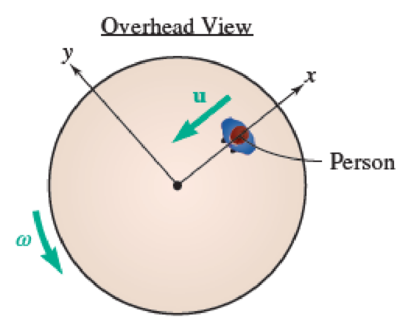
Concept explainers
A person walks radially inward on a platform that is rotating counterclockwise about its center. Knowing that the platform has a constant angular velocity ω and the person walks with a constant speed u relative to the platform, what is the direction of the acceleration of the person at the instant shown?
a. Negative x
b. Negative y
c. Negative x and positive y
d. Positive x and positive y
e. Negative x and negative y

Fig. P15.CQ8
Trending nowThis is a popular solution!

Chapter 15 Solutions
VECTOR MECHANIC
Additional Engineering Textbook Solutions
DeGarmo's Materials and Processes in Manufacturing
Fundamentals of Heat and Mass Transfer
Thinking Like an Engineer: An Active Learning Approach (4th Edition)
Statics and Mechanics of Materials (5th Edition)
EBK FUNDAMENTALS OF THERMODYNAMICS, ENH
Applied Statics and Strength of Materials (6th Edition)
- Problem (1) A belt-driven pulley and attached disk are rotating with increasing angular velocity. If at a given instant, the speed of the belt is v = 1.5 m/s, and the total acceleration of point A is 100 m/s?, determine: (a) The angular acceleration a of the pulley and disk (b) The total acceleration of point B (c) The acceleration of point C on the belt. A 150 mm 200 mmarrow_forwardPlease don't provide handwritten solution ....arrow_forwardProblem (8) The belt shown moves over two pulleys without slipping. At the instant shown the pulleys are rotating clockwise and the speed of point B on the belt is 4 m/s, increasing at the rate of 32 m/s?. Determine, at this instant, (a) the angular velocity and angular acceleration of each pulley, (b) the acceleration of point P on pulley C. B 160 mm fi00 mmarrow_forward
- 15.113 The 360-mm-radius flywheel is rigidly attached to a 30-mm- radius shaft that can roll along parallel rails. Knowing that at the instant shown the center of the shaft has a velocity of 24 mm/s and an acceleration of 10 mm/s, both directed down to the left, determine the acceleration (a) of point A, (b) of point B. A 2₂x 360 mm- 20° Barrow_forward2) At the instant given, it is known that the angular velocity of rod AB is 20 rad/s clockwise. By use of Cartesian vector form, determine (a) the angular velocity of rod BD, (b) the velocity of the point D. 0.2 m 0.25 m D 0.2 m E -0.6 m Barrow_forwardQ2. The crane shown rotates at the constant rate w = 0.3 rad/s; simultaneously, the telescoping boom is 1 2 being lowered at the constant rate w = 0.60 rad/s. Knowing that at the instant shown the length of the boom is 20 ft and is increasing at the constant rate u= 1.7 ft/s determine the acceleration of Point B. Z 30° مدل @0₁ JEDIDEDIREroso @0₂ Xarrow_forward
- B10arrow_forwardProblem (5) The rectangular block shown rotates about the diagonal OA with a constant angular velocity of 6.76 rad/s. Knowing that the rotation is counterclockwise as viewed from A, determine the velocity and acceleration of point B at the instant shown. 240 mm 100 mm 312 mm B 312 mmarrow_forwardA straight rack rests on a gear of radius r= 3 in. and is attached to a block B as shown. Knowing that at the instant shown 8 = 20°, the angular velocity of gear D is 4 rad/s clockwise, and it is speeding up at a rate of 2.5 rad/s², determine the angular acceleration of AB and the acceleration of block B. The angular acceleration of AB is The acceleration of block B is rad/s² clockwise. (Round the final answer to three decimal places.) in./s2. (Round the final answer to one decimal place.)arrow_forward
- The assembly shown consists of two rods and a rectangular plate BCDE that are welded together. The assembly rotates about the axis AB with a constant angular velocity of 16 rad/s. Knowing that the rotation is counterclockwise as viewed from B, determine the velocity and acceleration of corner E. 225 mm 500 mm The velocity of corner Eis ( The acceleration of corner Eis -( 300 mm m/s)i + 1 m/s²)i + x m/s)j. /s²)j + m/s +( m/s²)k.arrow_forwardA The 18-in.-radius fly wheel is rigidly attached to a 1.5-in. -radius shaft that can roll along parallel rails. Knowing that at the instant shown the center of the shaft has a velocity of 1.2 in/s and an acceleration of 0.5 in/s?, both directed down to the left, determine the acceleration (a) of point A, (b) of point B. 18 in. 20 Вarrow_forwardTHIS IS A SUPPLEMENTAL STUDY PROBLEM GIVEN AS AN EXTRA EXAMPLETHIS IS NOT A GRADED ASSIGNMENTarrow_forward
 Elements Of ElectromagneticsMechanical EngineeringISBN:9780190698614Author:Sadiku, Matthew N. O.Publisher:Oxford University Press
Elements Of ElectromagneticsMechanical EngineeringISBN:9780190698614Author:Sadiku, Matthew N. O.Publisher:Oxford University Press Mechanics of Materials (10th Edition)Mechanical EngineeringISBN:9780134319650Author:Russell C. HibbelerPublisher:PEARSON
Mechanics of Materials (10th Edition)Mechanical EngineeringISBN:9780134319650Author:Russell C. HibbelerPublisher:PEARSON Thermodynamics: An Engineering ApproachMechanical EngineeringISBN:9781259822674Author:Yunus A. Cengel Dr., Michael A. BolesPublisher:McGraw-Hill Education
Thermodynamics: An Engineering ApproachMechanical EngineeringISBN:9781259822674Author:Yunus A. Cengel Dr., Michael A. BolesPublisher:McGraw-Hill Education Control Systems EngineeringMechanical EngineeringISBN:9781118170519Author:Norman S. NisePublisher:WILEY
Control Systems EngineeringMechanical EngineeringISBN:9781118170519Author:Norman S. NisePublisher:WILEY Mechanics of Materials (MindTap Course List)Mechanical EngineeringISBN:9781337093347Author:Barry J. Goodno, James M. GerePublisher:Cengage Learning
Mechanics of Materials (MindTap Course List)Mechanical EngineeringISBN:9781337093347Author:Barry J. Goodno, James M. GerePublisher:Cengage Learning Engineering Mechanics: StaticsMechanical EngineeringISBN:9781118807330Author:James L. Meriam, L. G. Kraige, J. N. BoltonPublisher:WILEY
Engineering Mechanics: StaticsMechanical EngineeringISBN:9781118807330Author:James L. Meriam, L. G. Kraige, J. N. BoltonPublisher:WILEY





